
The Asclepeion on Kos
The Ancient Greek Medical School
Kos is one of the Dodecanese,
literally the "Twelve Islands"
but there are many more than that.
They're in the eastern Aegean, close to the coast
of Turkey.
Kos has one of the primary examples of an
Ασκληπείο
or Asclepeion,
a healing temple dedicated to Asclepius,
a doctor–demigod.
There were many Asclepeions
throughout ancient Greece and the subsequent Hellenistic
and Roman cultures.
However, the one on Kos was the most significant one.
Asclepius was said to be so skilled that he could even
raise people from the dead, so temples dedicated to him
were quite popular.
This is where Hippocrates,
the "Father of Medicine", received his medical training
and then practiced and taught medicine.
Those seeking healing first went through
κάθαρση
or katharsis,
purification through purging.
The toilets of the Asclepeion would have seen
a lot of use.
Let's see the ancient public toilets and other plumbing!
The Asclepeion is just outside the modern town of Kos. It's only about 4 kilometers from the harbor, an easy walk of about an hour.
We have arrived, bought our ticket, and entered the site. We're at the Propylon or entrance steps at the north edge of the sanctuary complex, looking south. The original temple here was built in the late 6th century BCE for the worship of Apollo. It was further on up the hill through the cypress forest in the background.
There are three terraces or levels. We are entering the First Terrace, built in the 4th century BCE. Arches and niches line the retaining wall leading up to the Middle Terrace. The other three sides of the First Terraces were each lined with a stoa or στοά, a long building open with columns instead of a wall along one long side. Their covered walkways opened onto the terrace area. We're standing within the northern stoa.
The First Terrace was the functional hospital area of the complex, where healing and teaching happened. There was lodging here for the patients. The Middle and Upper Terraces were the sacred areas.
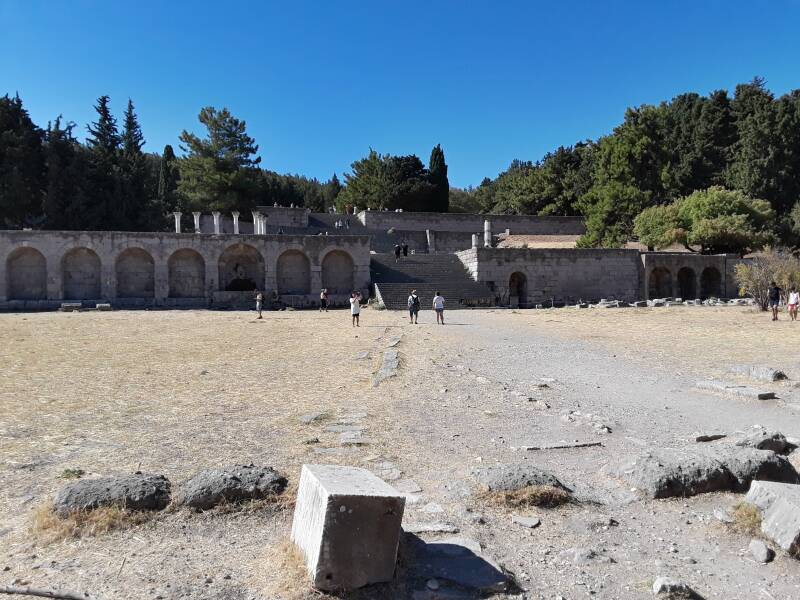
You are given this plan of the Asclepeion with your ticket.
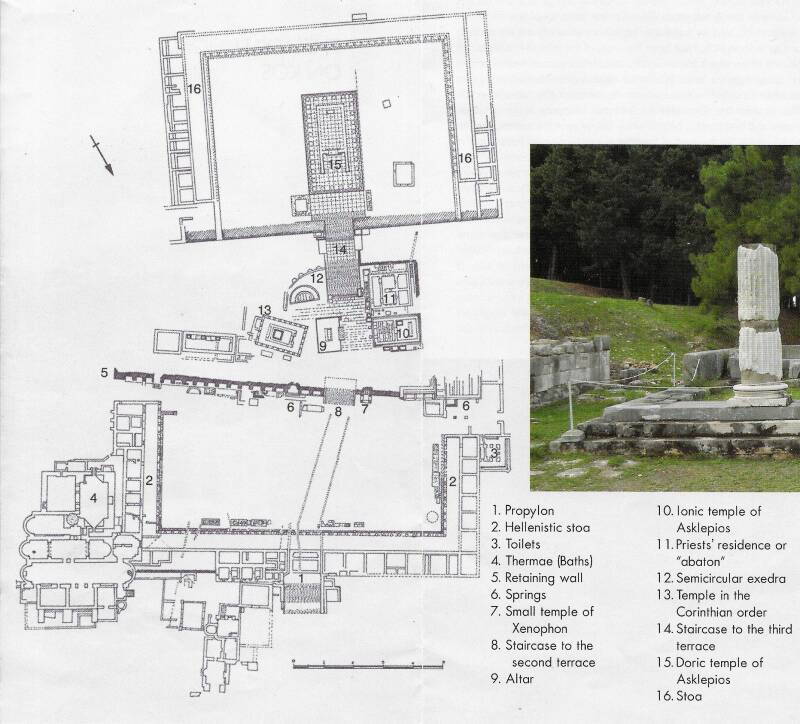
This drain is alongside the entrance steps. Kos is quite dry, like most Greek islands. Very little rain falls from late April through mid October. But when the rain falls in winter, there would be plenty of water to drain away from the open First Terrace.
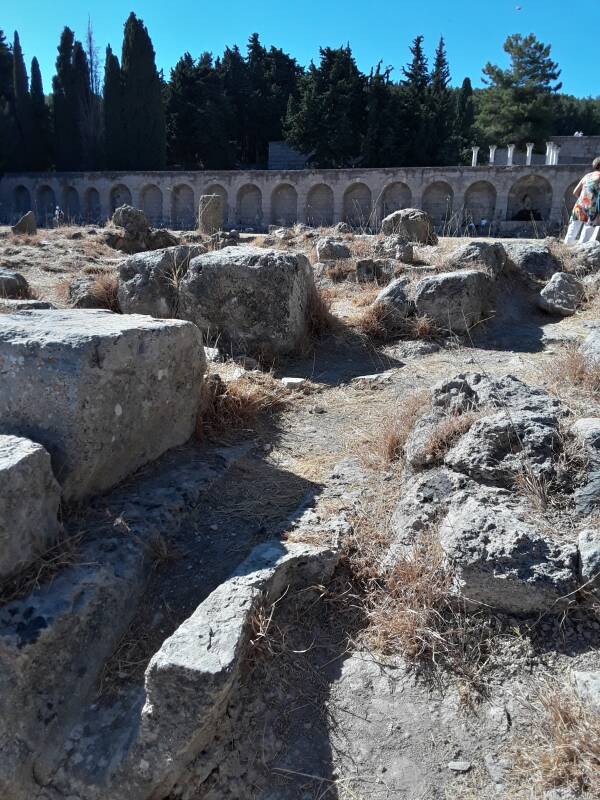
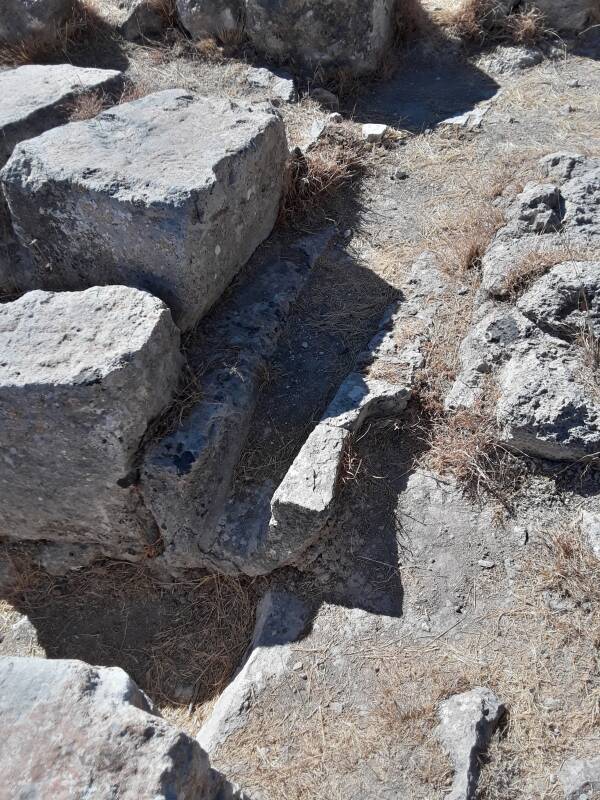
The niches along the upper side of the First Terrace held statues and fountains.
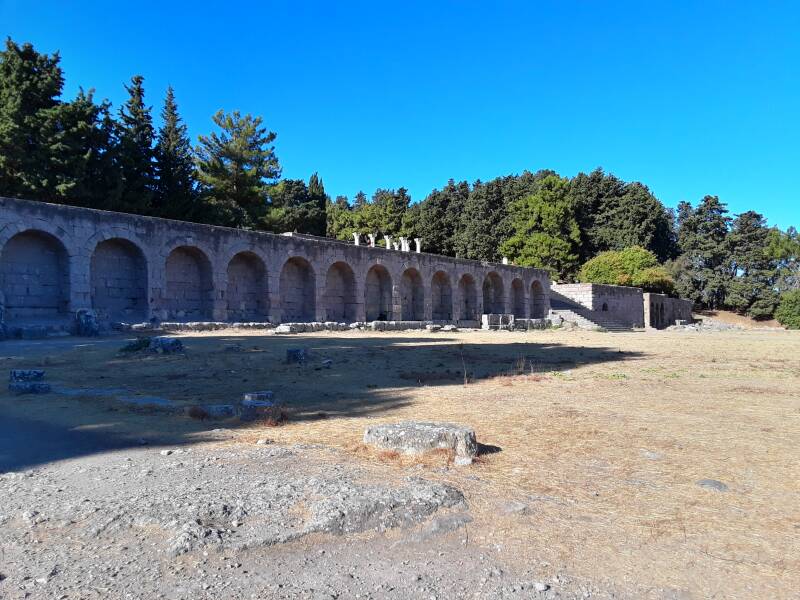
One niche most of the way from the left end to the central stairs holds a fountain with an eroded relief of the god Pan playing the syrinx. Today we call them "panpipes", but the medical term σύριγγα or syringe was derived from σύριγξ or syrinx.
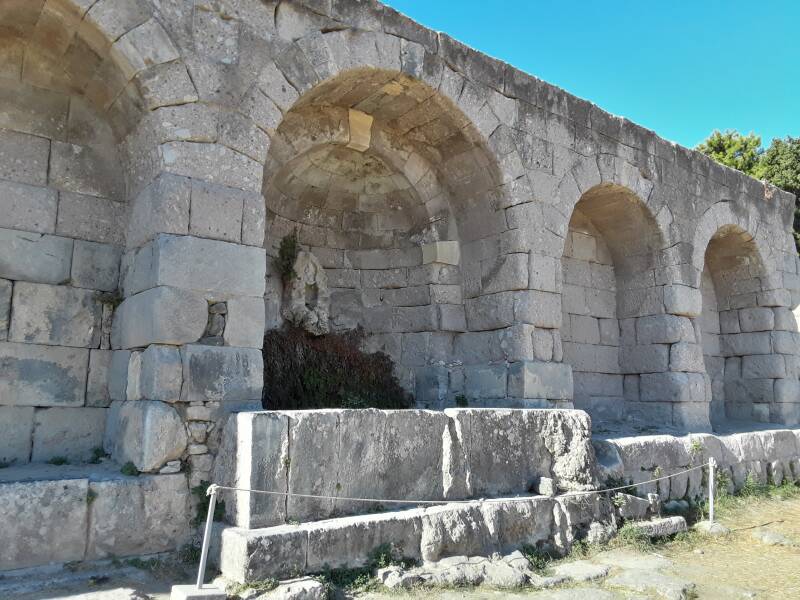
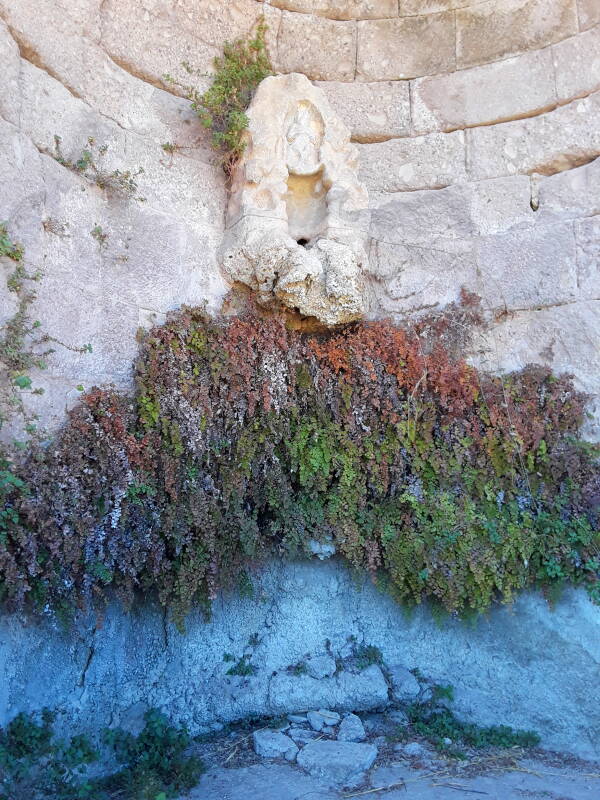
Nero's Toilet
To the left of these was a pedestal with a statue of the Emperor Nero as Asclepius. The statue is gone, but the pedestal and its legible inscription remains. The statue was dedicated by Xenophon, a 1st century physician from Kos who practiced at the Imperial court in Rome, and who also endowed a medical library at this sanctuary.
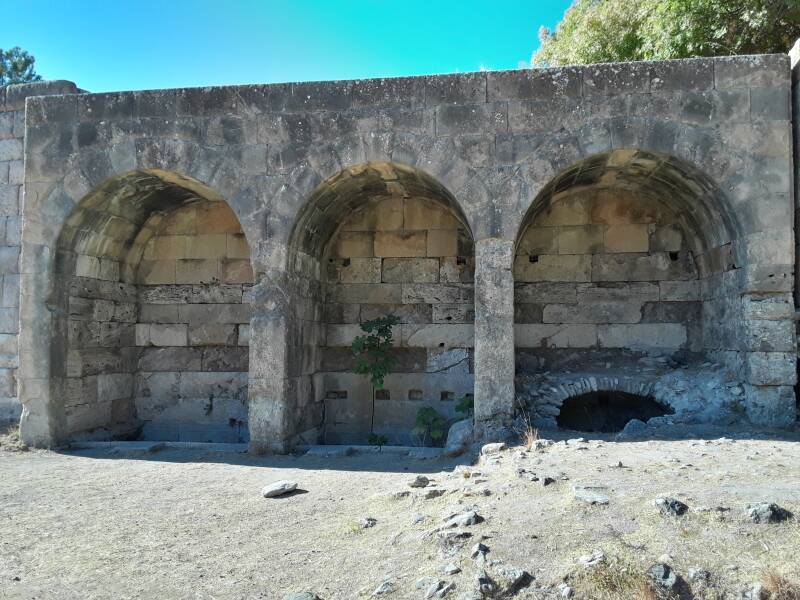
Three arched niches further to the right of the central staircase held therapeutic thermal water pools. The curative thermal springs in this area had led to the cult of Asclepius first taking form here.
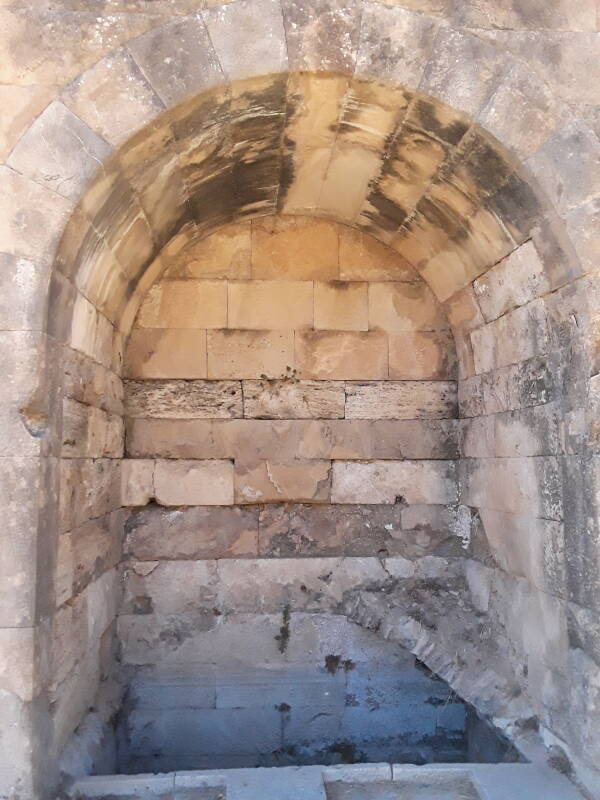
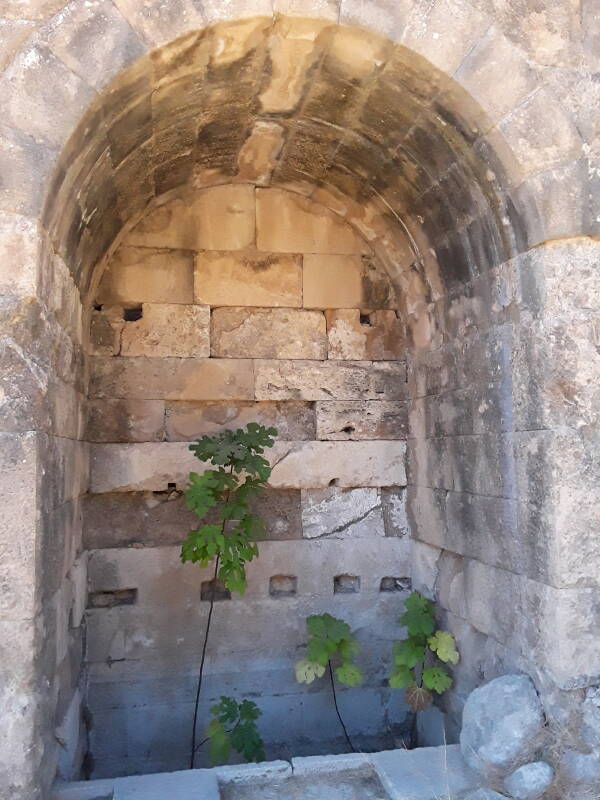
The thermal fountains no longer function, but the water pools remain moister than the open First Terrace.
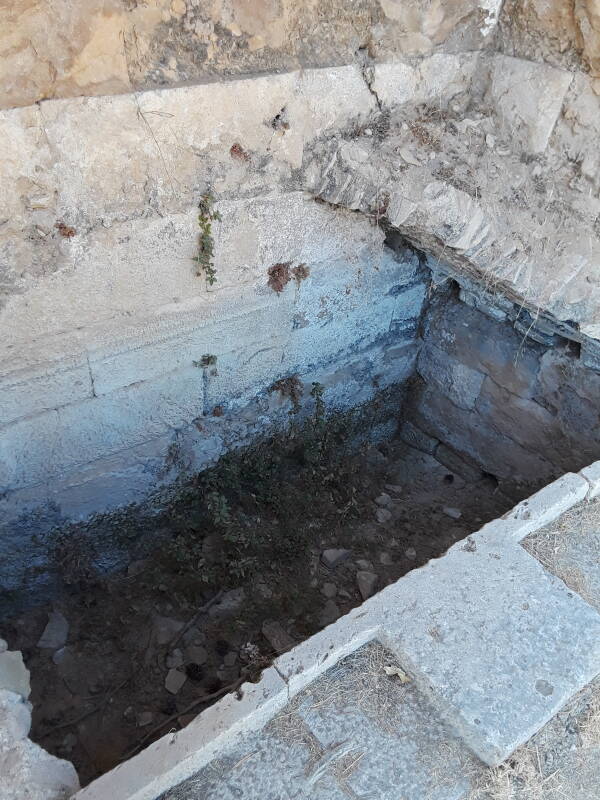
Here is the large public toilet at the right rear or southwest corner of the First Terrace.
A patient seeking admission into the Asclepeion first went through katharsis or purification — cleansing baths, purgatives, and a cleansing diet, for several days. Meditation and chanting could help transition the patient into a hypnotic state.
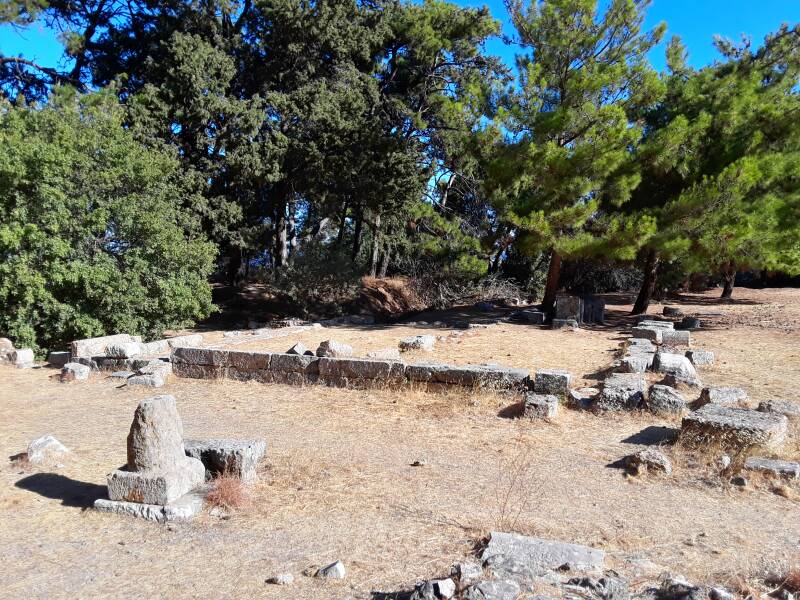
Asclepeions contained carefully designed and controlled spaces conducive to healing. Treatment at the temple focused on promoting healthy lifestyles, with a special emphasis on the patient's spiritual needs.
The treatment included incubation, a religious practice of sleeping in a sacred space in the hope of experiencing a divinely inspired dream that explained a cure. The practitioners were a hybrid of physician and priest. At Kos one hoped that Asclepius himself or one of his healing children would visit the patient in a dream, relating what they needed to do to cure their ailment.
Asclepius was said to have been so skilled that he could raise people from the dead. Homer described him in the Iliad as a man, a physician tending to soldiers injured at Troy. By the time of Hippocrates, 460–377 BCE, Asclepius had been elevated to godhood, the descendant of the god Apollo and the mortal Coronis.
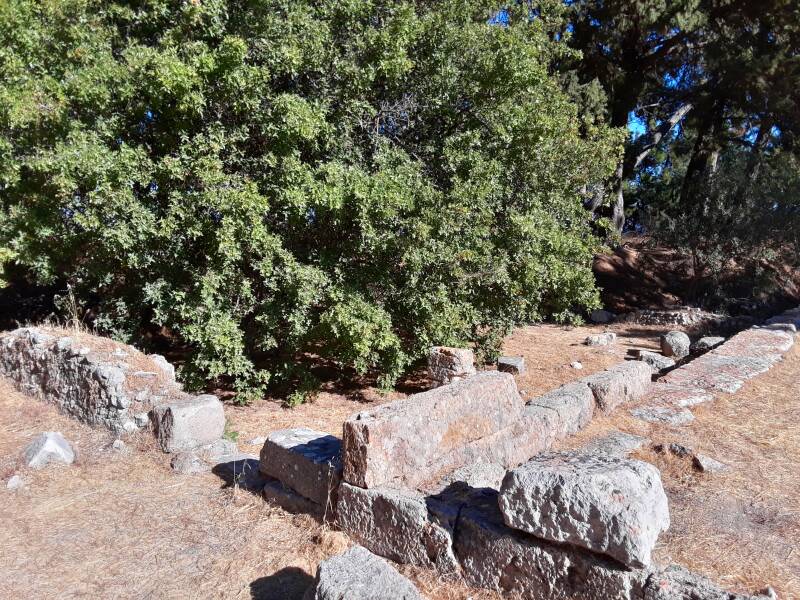
Case histories describe opening abdominal abscesses, and post-trauma removal of foreign objects. These may have occurred with the patient in a dream-like state of induced sleep called έγκοίμησις or enkoimesis, a state similar to anesthesia, induced with the help of opium.
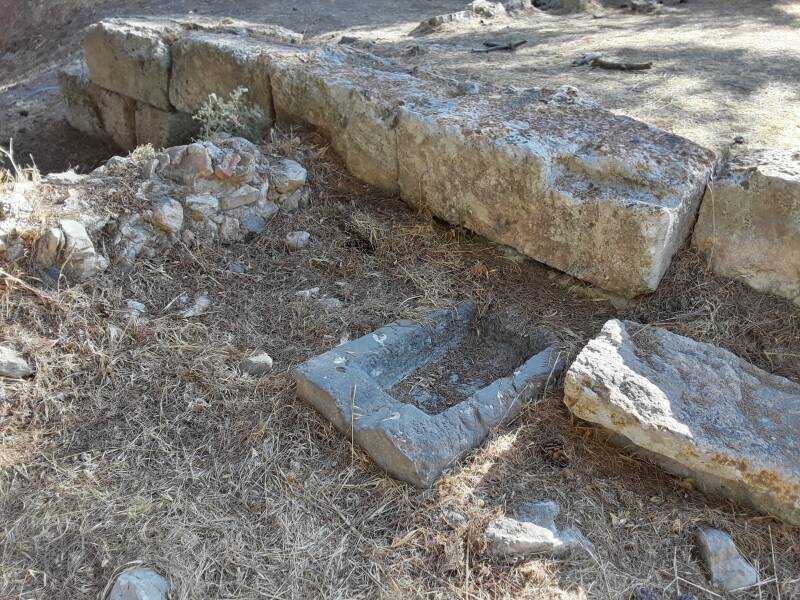
What should you do after you use the toilet? Wash your hands.
This large rectangular washing basin was next to the toilets, at the base of the retaining wall.
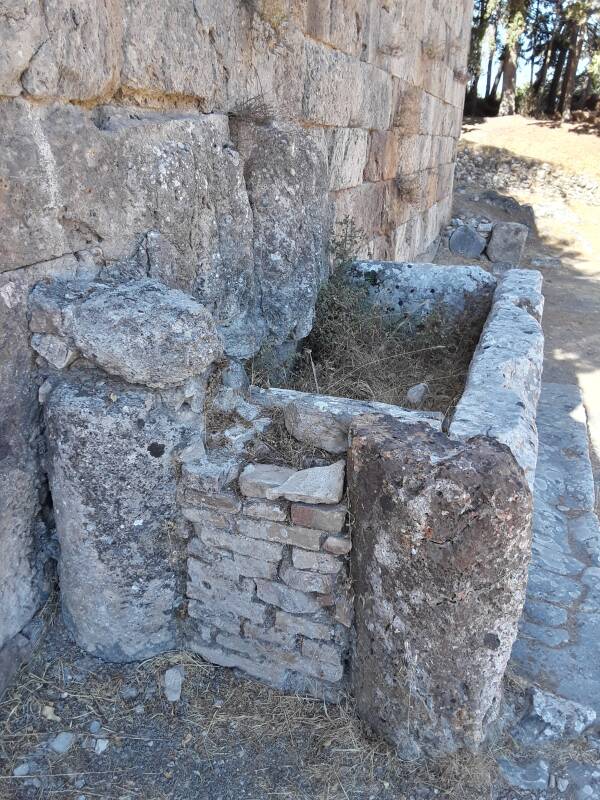
We have ascended to the Middle Terrace and are looking back down at the public toilets.
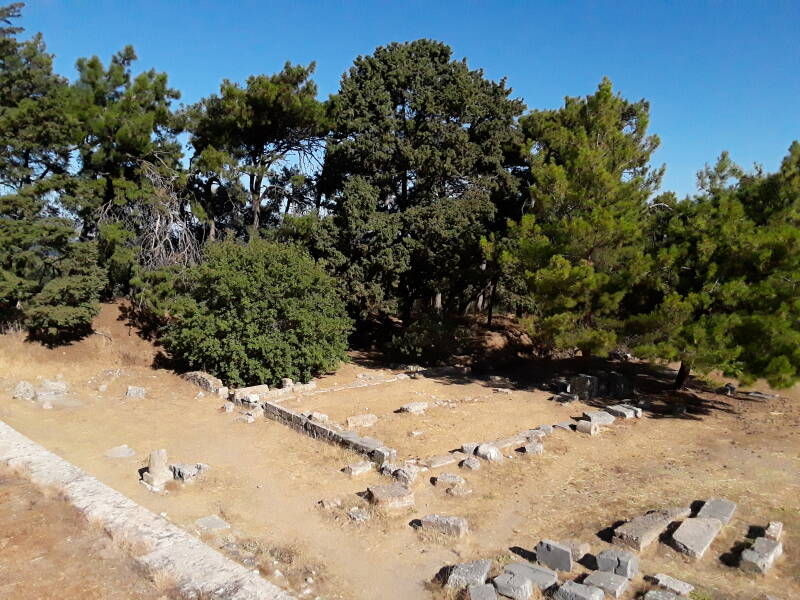
The so-called abaton or άβατον takes its name from Greek Orthodox tradition, referring to parts of monasteries accessible only to monks or only to male visitors. Its function remains unclear. It is most often said to be a special place in the sacred area where the sick would sleep, their incubation in hopes of a dream visit from Asclepius. But it might have been a residence for the more priestly of the physician–priests of the staff.
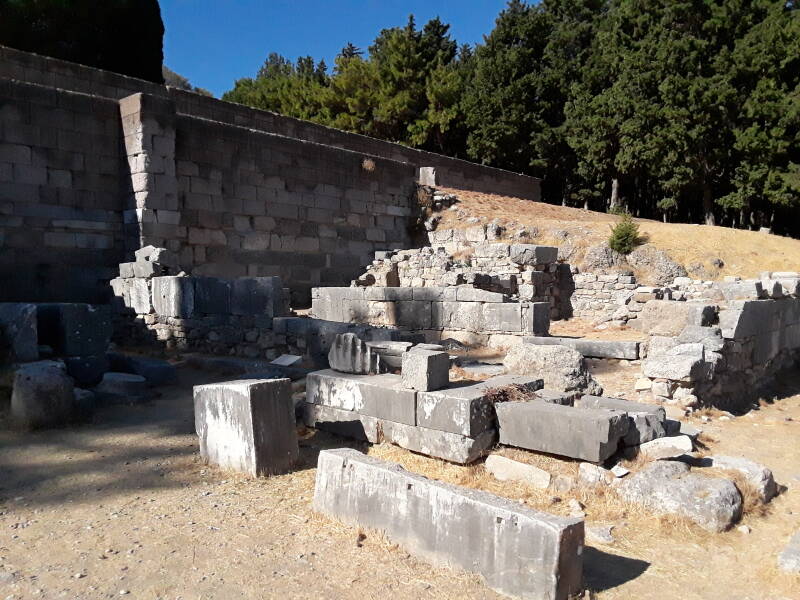
Whoever slept there, it was somehow connected to the underground spring at its southwest corner, accessed by this stairway leading beneath the second retaining wall,
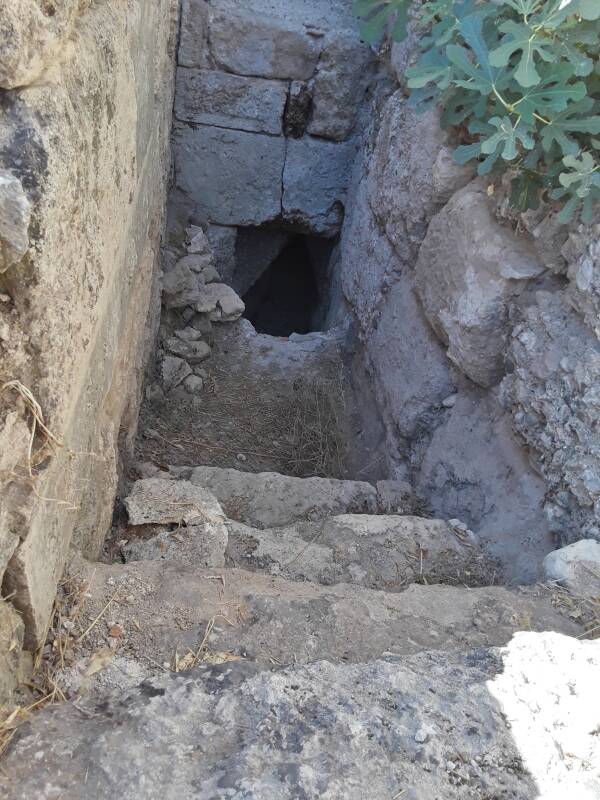
Terracotta water supply lines are visible along the north side of the abaton.
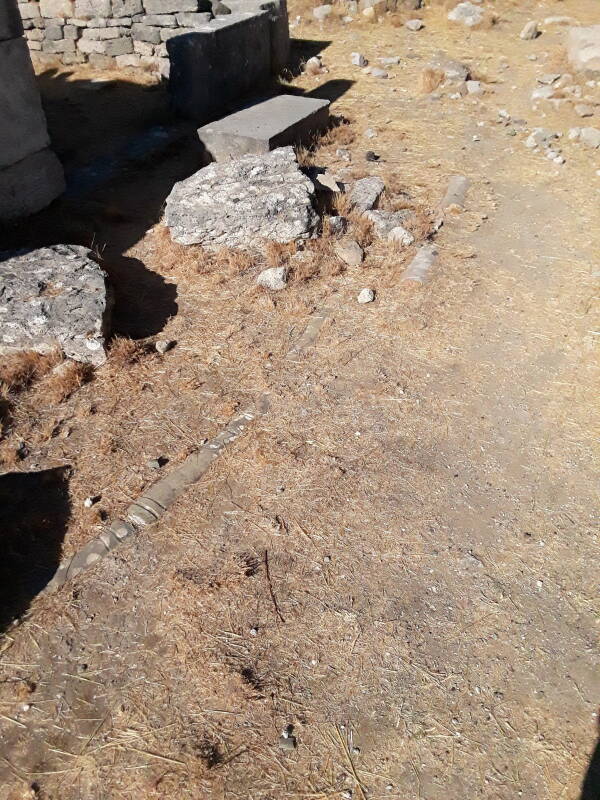
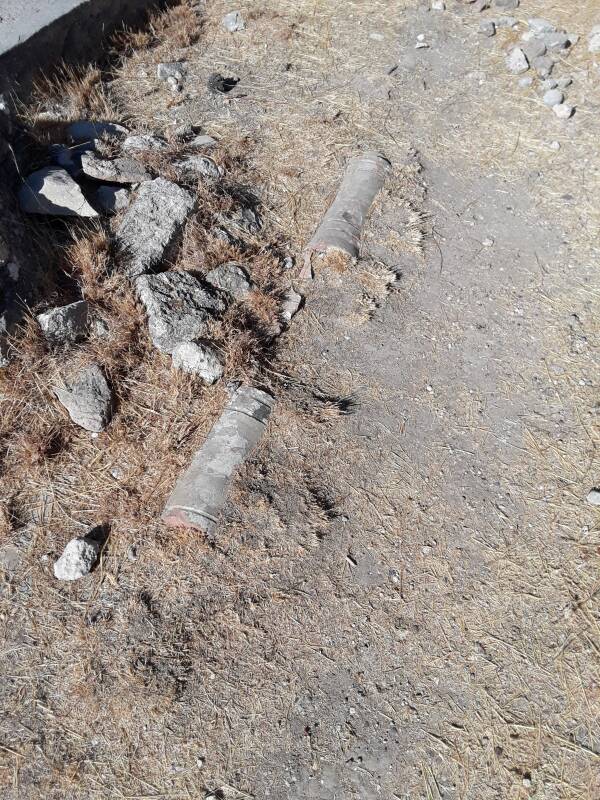
Ascending further, we reach the Third Terrace. The 6th century BCE shrine to Apollo was further up the hill into the cypress forest.
The Greater Temple to Asclepius was built here in 160–170 BCE. Its original 32 columns were hauled away by the Knights of Rhodes for their castle at Kos harbor.
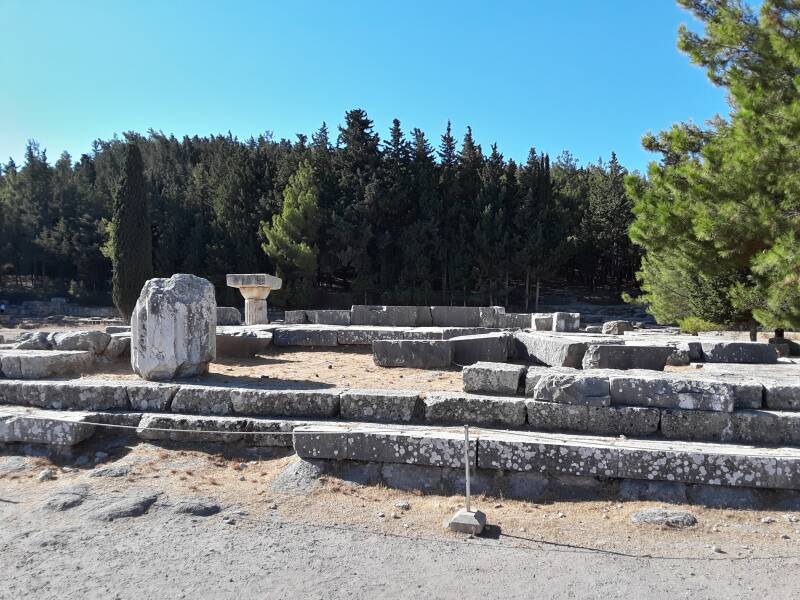
Turning and looking north from the top of the staircase to the Upper Terrace we have a fantastic view down across the Asclepeion, to Kos town at the water's edge, and across the strait to the mainland of Asia Minor, today's Turkey.
Looking from left to right across the Middle Terrace we see the First Temple of Asclepius, the Main Altar of the entire sanctuary, and the Temple of Apollo with its seven almost entirely non-original reconstructed columns.
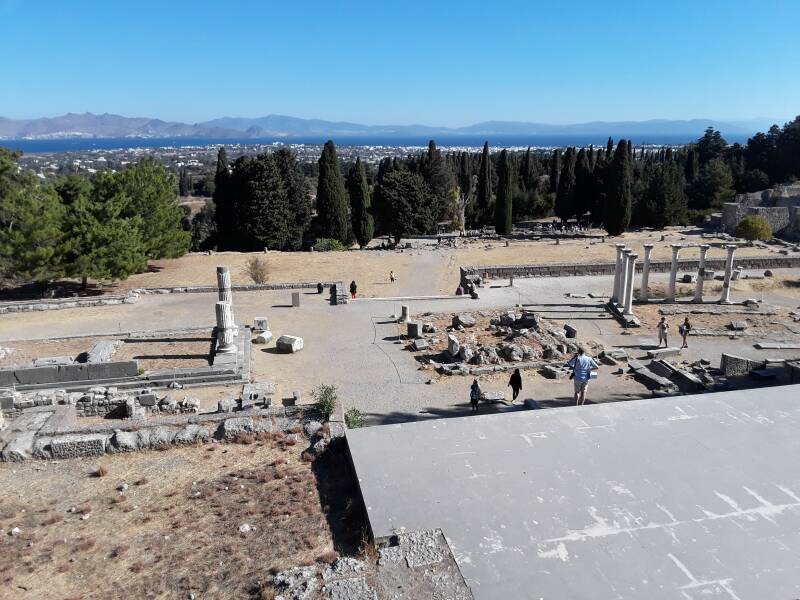
The First Temple of Asclepius, at left, was built around 300 BCE. Along its south side, nearest to us, is a large stone coffer in its floor. This thesauros or treasury has a large monolithic lid with a hole in the center where pilgrims would deposit offerings. Many patients would return here after their recovery to leave thankful offerings.
The Main Altar, at center, was built around 350 BCE. It was modified in the 3rd century BCE to be a stepped altar similar to the altar of Dionysus in Kos town, which we will see below. The main altar was sacred to both Apollo and Asclepius, and the Temple of Apollo at right was specific to that deity.
Apollo was the god of medicine and healing. Asclepius was the son of Apollo and Coronis, or of Apollo and Arsinoe, or of Apollo alone, depending on which version of the myth you read.
Apollo was the foster father of the centaur Chiron or Χείρων. Centaurs were usually like frat boys on an ether binge, but Chiron was unusually intelligent and kind. Apollo taught the art of medicine to Chiron, who became a great healer. Then Chiron taught Asclepius. And so, Chiron was the first centaur for disease control.
The public toilets are under the trees at the far left of the above picture. The large structure off the First Terrace at the far right of that picture is the Roman baths. Let's descend and look at those.
The area around the Roman baths, built in the 3rd century CE, has many terracotta water supply lines protruding from the surface.
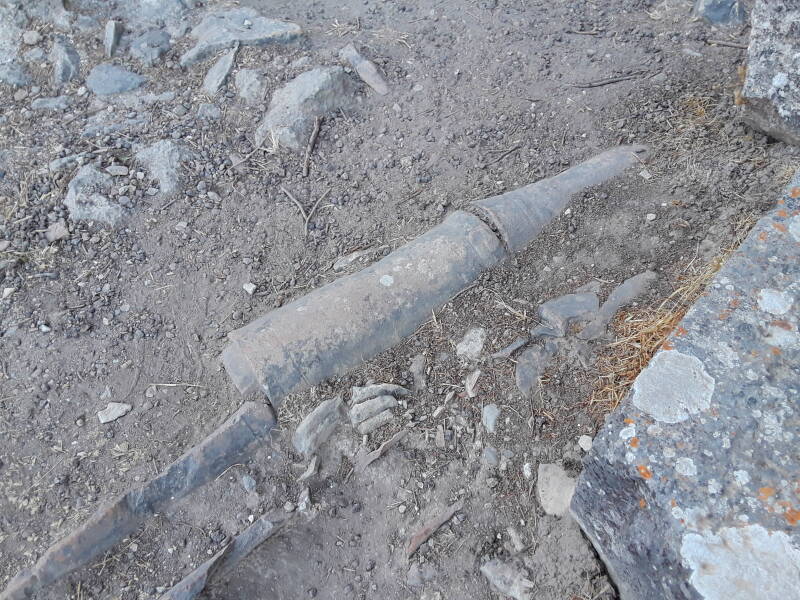
The Asclepeion was in use until 540 CE, early Byzantine times. It had been a healing center for about nine centuries. But by the time of the Byzantine destruction of non-Christian shrines, the Kos Asclepeion had been long abandoned, overgrown, and buried by blown-in soil.
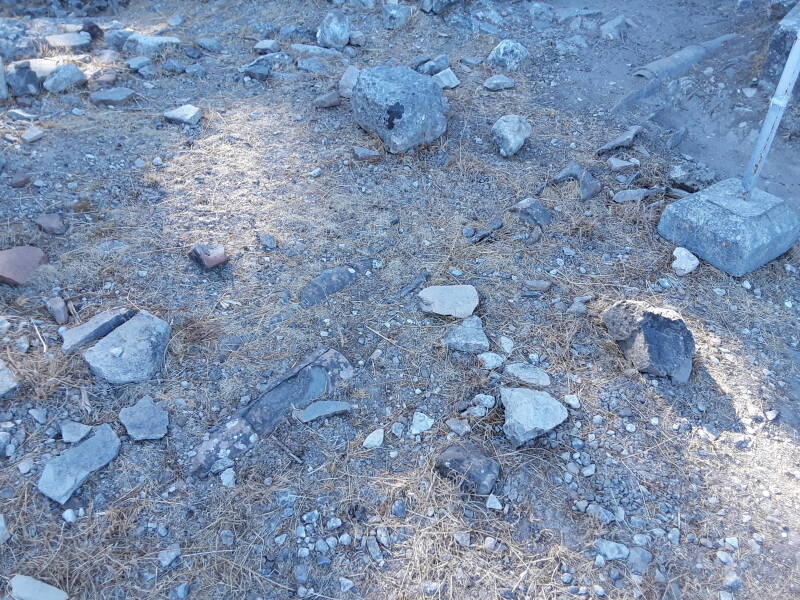
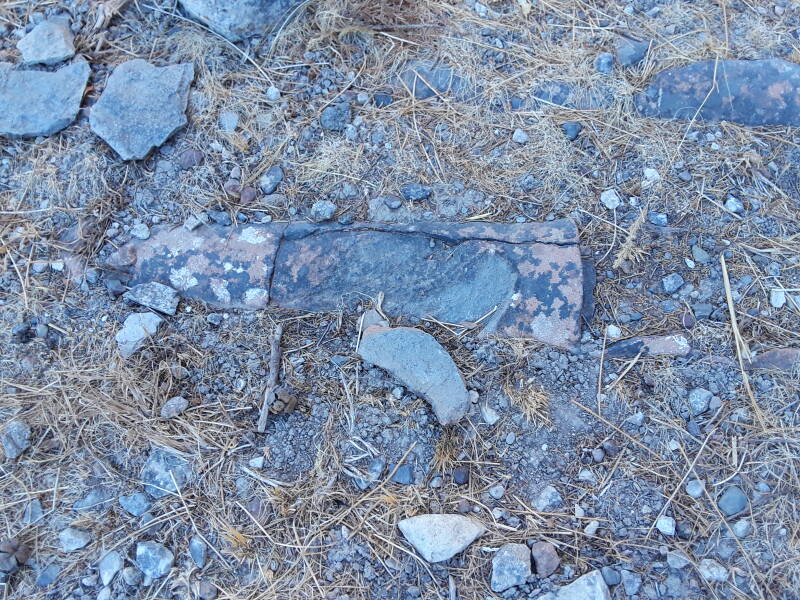
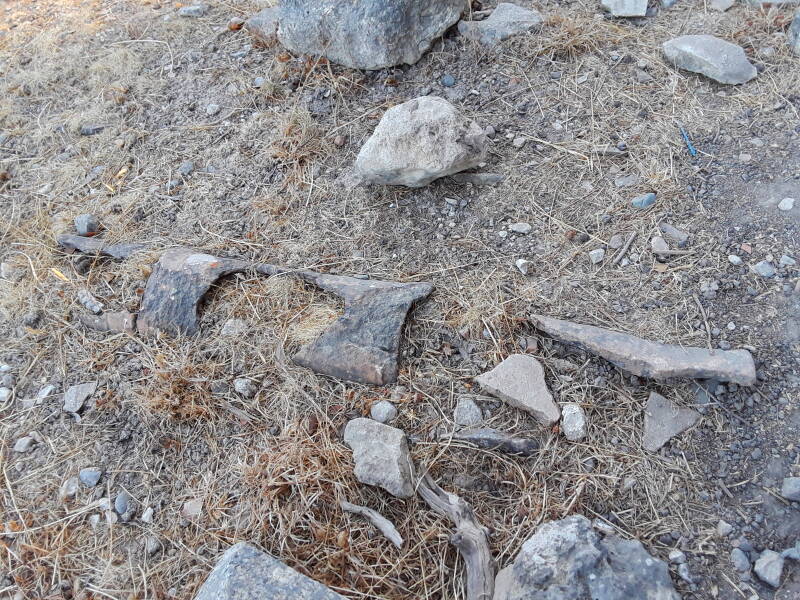
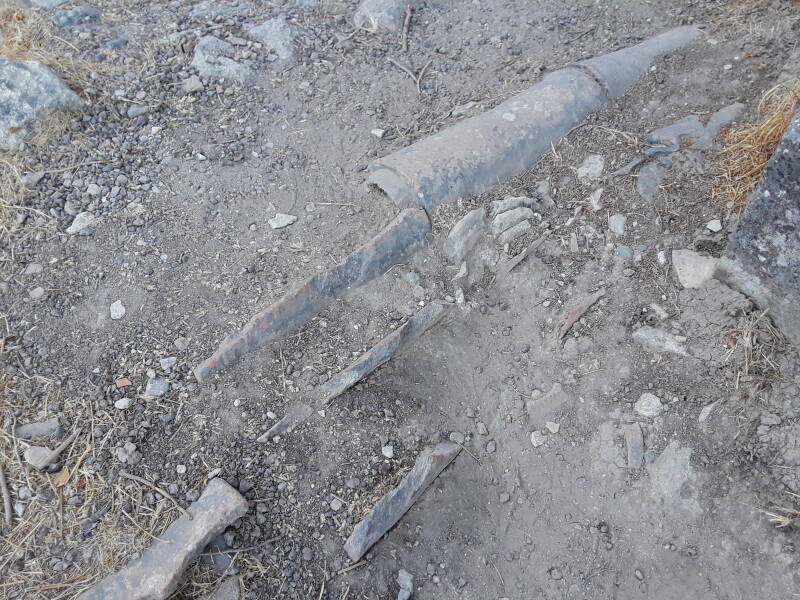
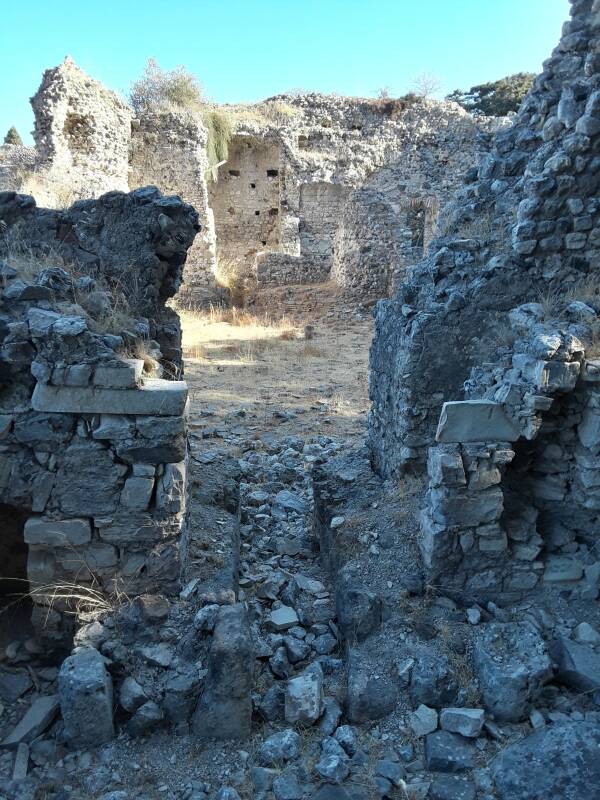
It's time to return to Kos town and see some ancient plumbing there. But first let's stop at the modern toilet at the Asclepeion.
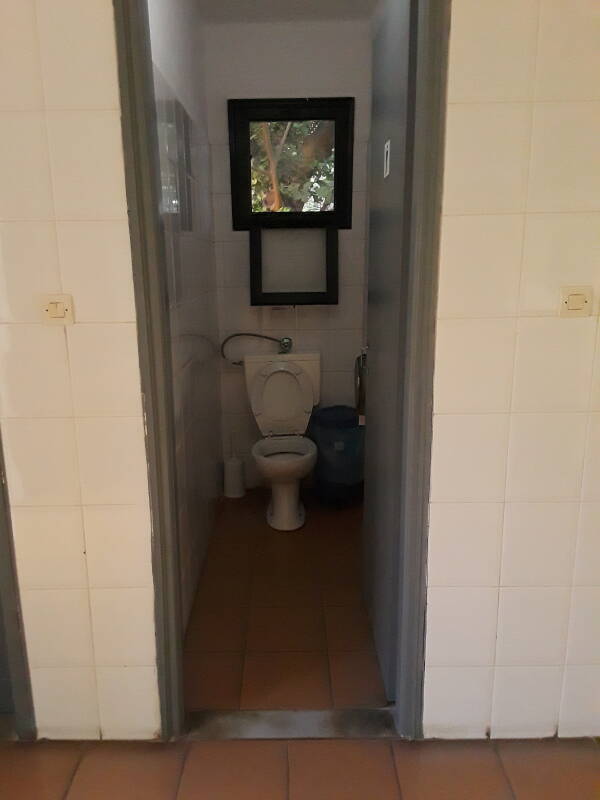
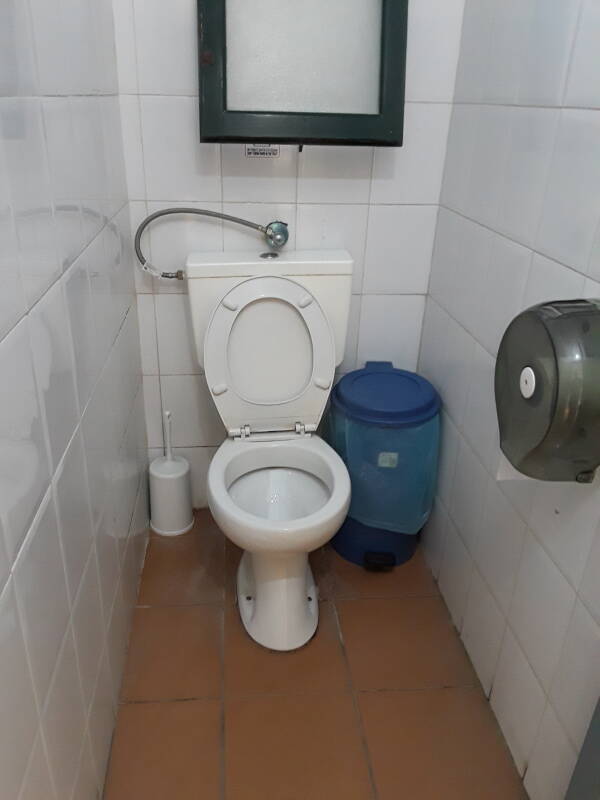
Ancient Kos
The Western Excavation Site in Kos town has ruins from Hellenistic times into Roman times. These ruins include some plumbing, let's explore!
There is a large bath in this area. We see the square supports for a raised heated floor in part of the bath, and an arched roof over part of it.
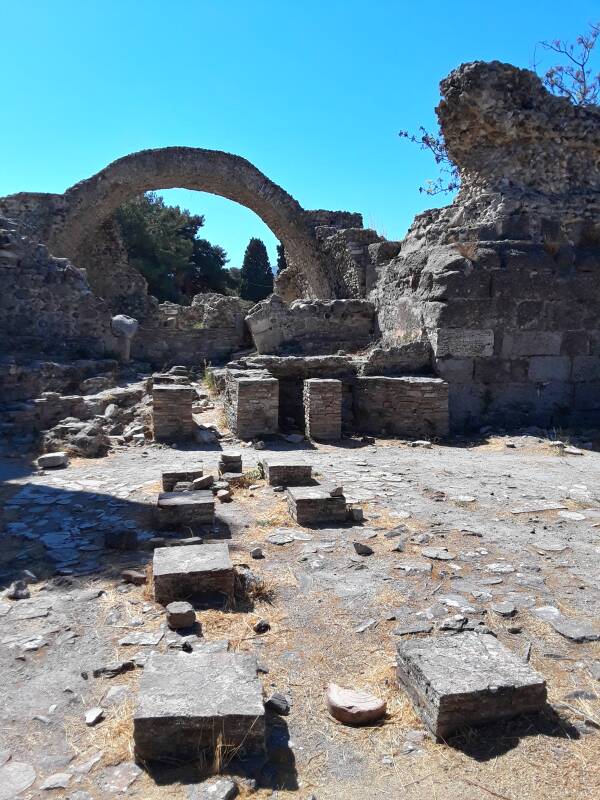
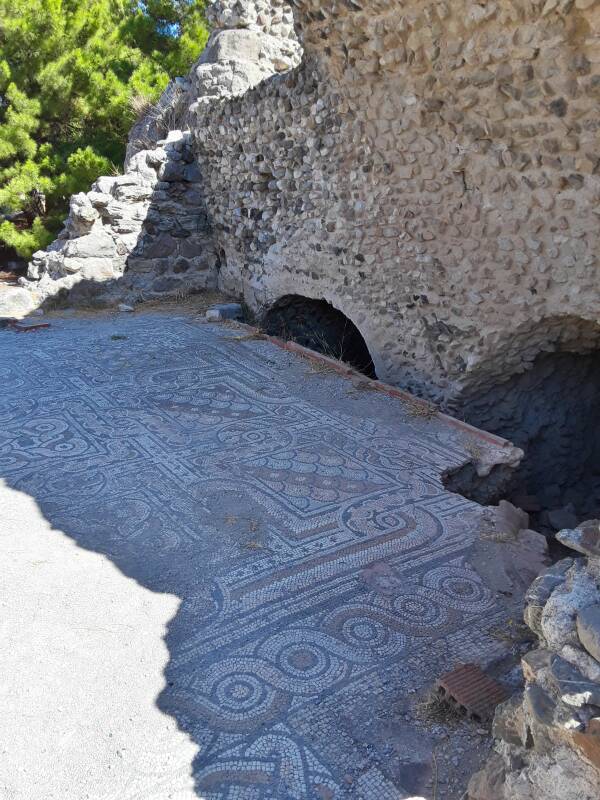
Kos is fairly large, 40 by 8 kilometers, with a population over 33,000, several beaches, and a busy airport. People fly there from all over Europe, sometimes just for a weekend visit.
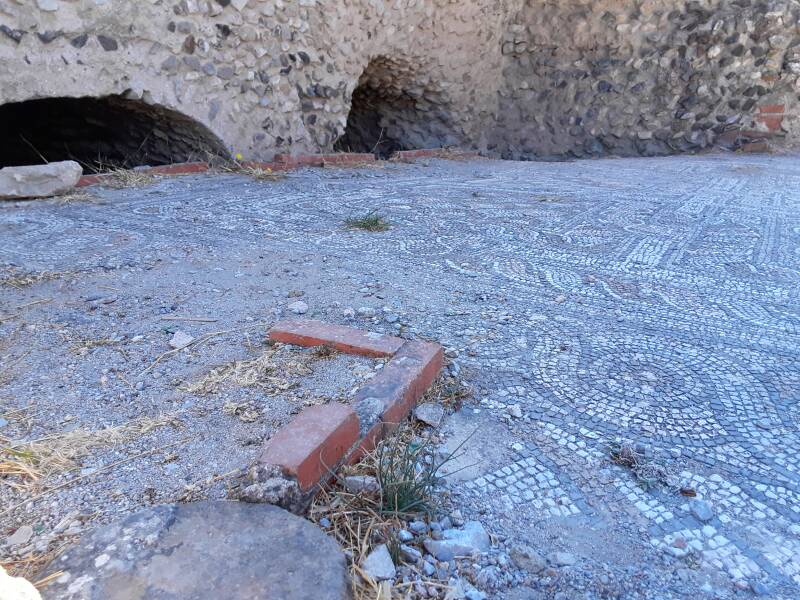
Many of the holiday visitors are intent on doing their glamour photography in the ruins. But there I am poking around in the background, discovering and documenting ancient toilets and other plumbing, ruining the ideal framing of the glamour posing. The Toilet Guru is interfering with their all-important Instagram activities.
Pouts were made. I believe that feet were even stamped. Oh well.
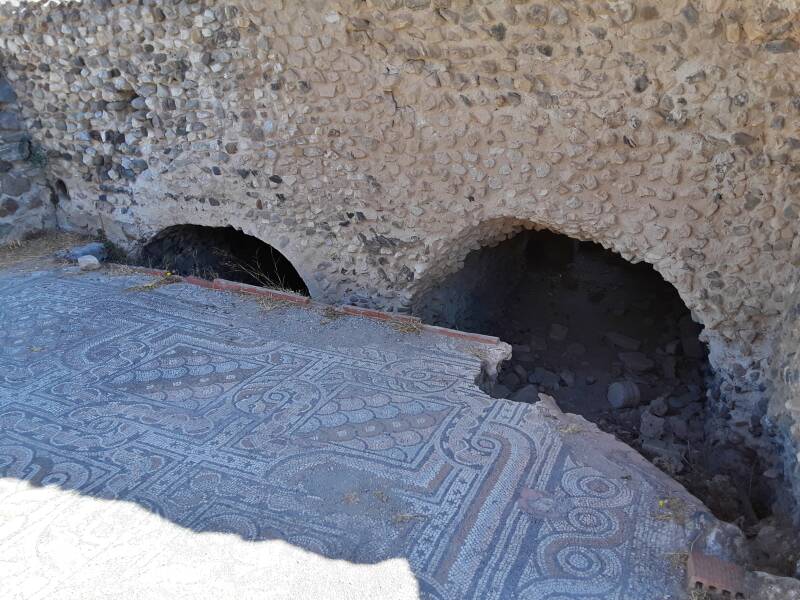
The Blue Guide for the Aegean Islands tries to direct you to a public toilet near the bath. However, they seem to be directing you to the Nymphaeum, a large, nearly cubical, building in which water was distributed.
Below are the ruins of what I believe to be the public toilet adjacent to the baths.
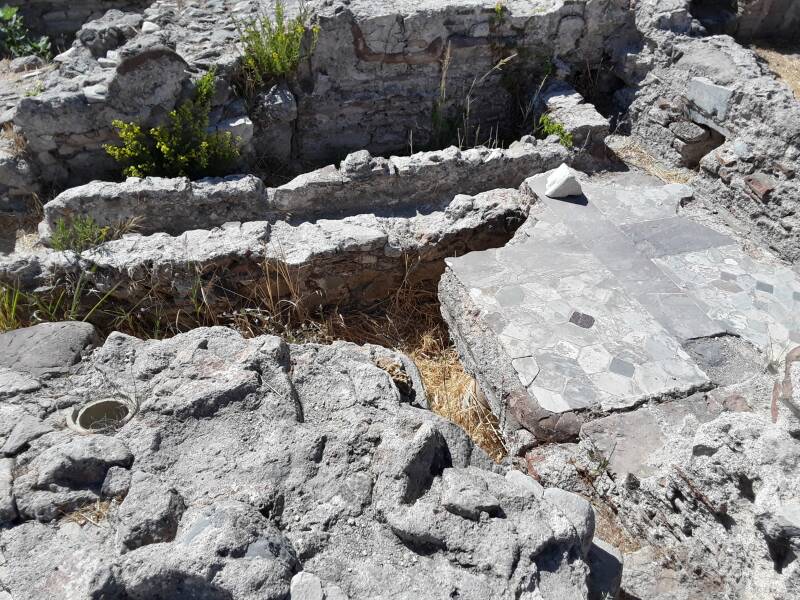
I interpret this as a waste channel, over which the row of seats would have been installed, with a channel for cleansing water running along the users' feet.
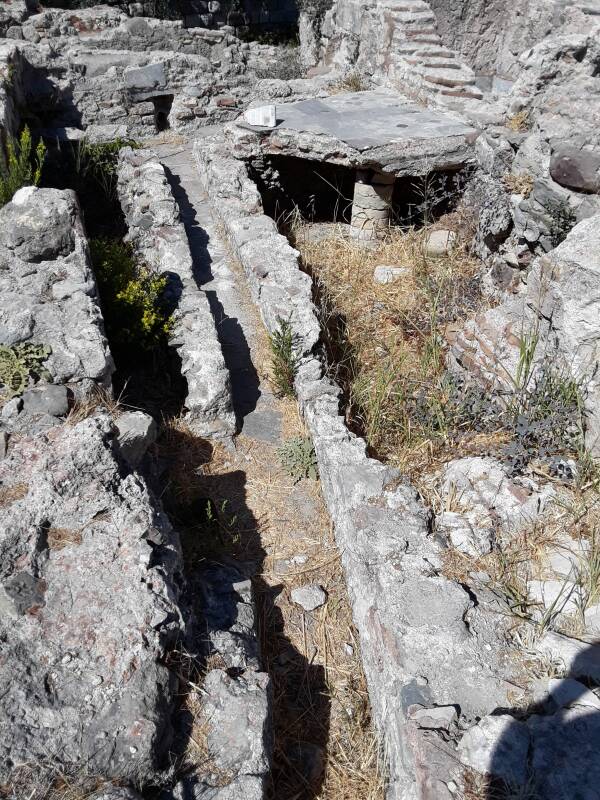
The Temple of the Attalids was built in the first half of the second century BCE, and remained in use until the Roman imperial period. It's next to the Altar of Dionysus, a few blocks south of the large agora near the port's waterfront.
The Temple of the Attalid is surrounded by stone pedestals, probably used for votive offerings. A colossal statue was found here, depicting the king Eumenes II of Pergamon (197–158 BCE). It was probably installed in the pronaos or anteroom of the temple, where Eumenes was worshipped as synnaos or temple-sharing with another deity, probably Dionysos, who was the founder of the House of the Attalids. Here we can easily see a drain line leading north from the temple.
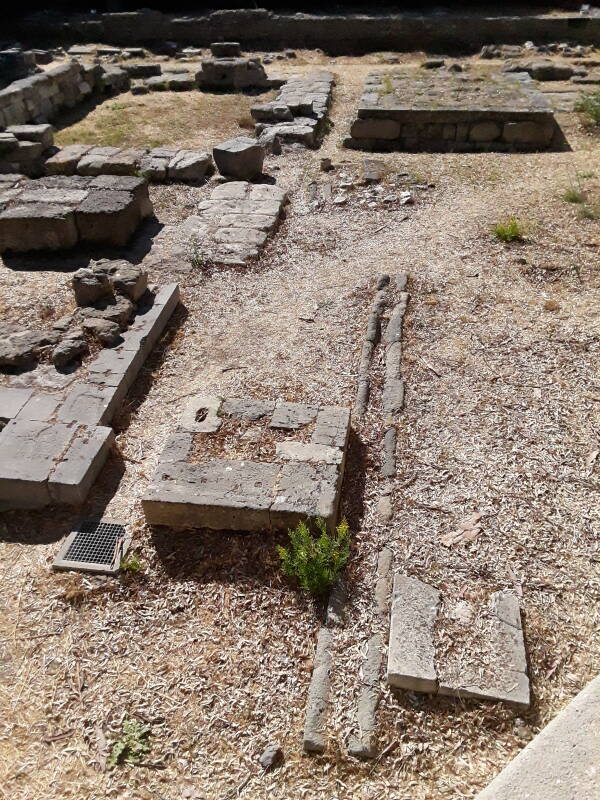
The altar of Dionysos, build in the mid-second century BCE, is next to the Temple of the Attalids. Its entrance was a ramp leading to the preparation are for the ritual, and the sacrificial table where the animal sacrifices were performed. This is the altar similar to the main altar at the Asclepeion.
It was damaged during the 143 CE earthquake, and then repaired. Toward the end of the 15th century, the Knights of Saint John largely disassembled it to build their Nerantzia castle.
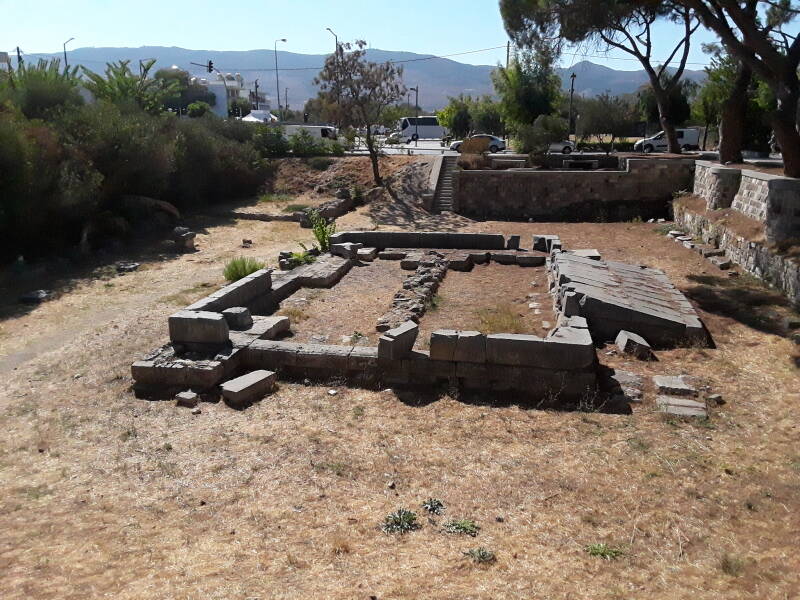
These terracotta water supply lines are along the West Stoa of the smaller agora near the Temple of Dionysus, a few blocks south of the large agora near the port's waterline. This stoa was first built in the late 4th to early 3rd century BCE, and modified at the beginning of the 2nd century CE.
The pipes and sewers (now mostly indistinct) date from the early Hellenistic period through early Christian times.
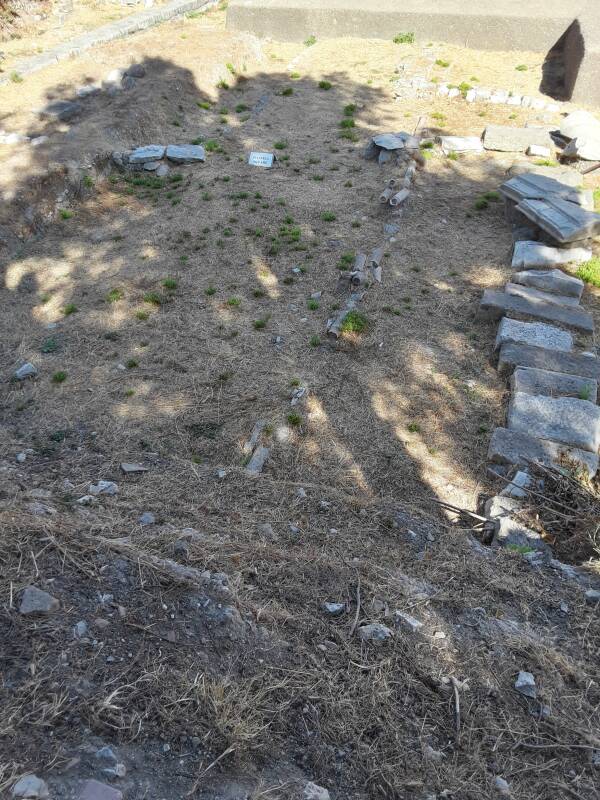
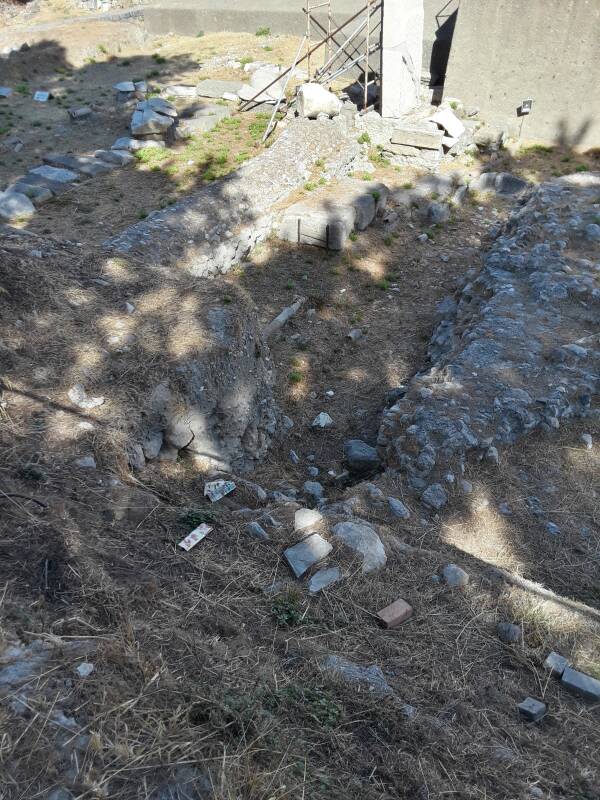
If neither a tersorium nor water were available, the Greeks and Romans used πεσσοι or pessoi, small stones, to clean themselves. The tradition started with the ancient Greeks that three stones should be enough to finish the job. This convention has been very long lived, with a hādīth attributed to Muhammad specifying three stones as the ideal number for anal cleaning. The pessoi were also used in an ancient board game in Greece. Aristophanes wrote a scene involving pessoi in Peace in the 5th century BCE. Here's the Penguin Classics translation:
Arms dealer [displaying a cuirass]: And what, alack, shall I do with this rounded cuirass, a beautiful fit, worth ten minas?
Trygaeus: Well, that one will not make a loss for you, anyway. Give me that at cost price. It will be very convenient to crap in ...
Arms dealer: Stop this impudent mockery of my goods!
Trygaeus [placing the cuirass on the ground like a chamber pot and squatting on it]: Like this, if you put three stones beside it. Is it not clever?
The Greeks would use όστρακα or ostraka, small pieces of broken ceramic goods, to vote to shun or ban their opponents. This is where we get the word ostracize. Some scholars have suggested that the ostraka could be used as pessoi, literally wiping your feces onto the names of hated individuals. The abrasive characteristics of broken ceramic material suggest that long-term used of these as pessoi could have resulted in localized irritation at the least, progressing to skin or mucosal damage or the irritation of external hemorrhoids. For more on toilet use of pessoi and ostraka and the medical implications see the paper "Toilet hygiene in the classical era", Philippe Charlier, Luc Brun, Clarisse Prêtre, and Isabelle Huynh-Charlier, in BMJ (the British Medical Journal) 2012, pages 345-346.
